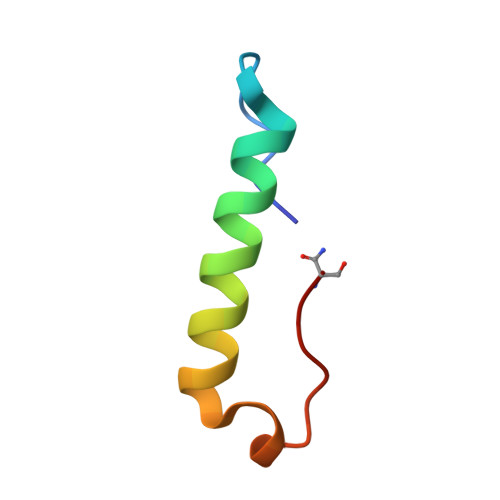Facilitated structure verification of the biopharmaceutical peptide exenatide by 2D heteronuclear NMR maps.
Mishra, S.H., Bhavaraju, S., Schmidt, D.R., Carrick, K.L.(2021) J Pharm Biomed Anal 203: 114136-114136
- PubMed: 34087552
- DOI: https://doi.org/10.1016/j.jpba.2021.114136
- Primary Citation of Related Structures:
7MLL - PubMed Abstract:
Exenatide is a peptide based anti-diabetic prescription medication. Until now, the literature has lacked a comprehensive atom-specific molecular characterization for this complex large peptide by NMR spectroscopy that can be effortlessly and rapidly utilized for biopharmaceutical structural veracity. Peptide structure verification by NMR is challenging and cumbersome when reliant on traditional proton-based methodology (through-bond and through-space proton connectivity) alone due to increasing complexity, low signal dispersion, and overlap. These challenges are overcome by using 2D heteronuclear ( 1 H- 13 C and 1 H- 15 N) maps that not only allow unambiguous signal assignment, but also condense the structural verification information within simplified peptide amide and carbon fingerprint maps. Here we report such simplified amide and carbon fingerprint maps for exenatide; made possible by the first ever comprehensive heteronuclear ( 1 H, 13 C, and 15 N) atom specific assignment of exenatide. These heteronuclear assignments were obtained without any isotopic enrichments i.e. at natural abundance, and hence are easily deployable as routine procedures. Furthermore, we compare the 2D heteronuclear maps of exenatide to a chemically identical peptide differing only in the isomerism of the Cα position of the first amino acid, [dHis1]-exenatide, to demonstrate the uniqueness of these maps. We show that despite deliberate changes in pH, temperature, and concentrations, the differences between the amide maps of exenatide and [dHis1]-exenatide are retained. The work presented here not only provides a facilitated structure verification of exenatide but also a framework for heteronuclear NMR data acquisition and signal assignment of large peptides, at natural abundance, in creating their respective unique 2D fingerprint maps.
- Reference Standards Laboratory, United States Pharmacopeial Convention, 12601 Twinbrook Parkway, Rockville, MD, 20852, United States. Electronic address: subrata.mishra@usp.org.
Organizational Affiliation:
















